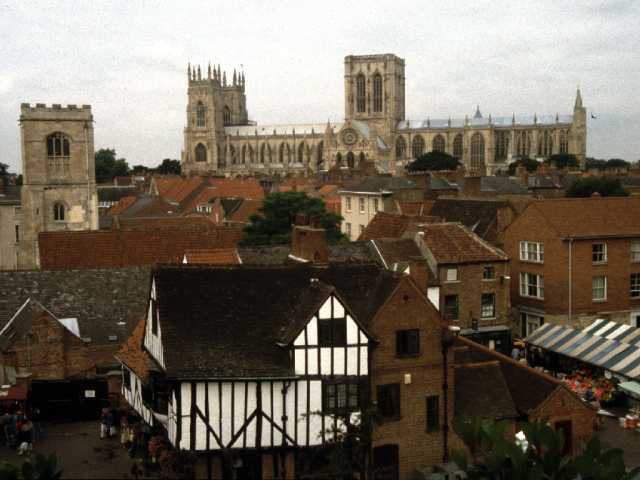

By far the most important settlement in Yorkshire in the Dark Ages was York. Named Eorforwic by the Saxons, a corruption of the roman Eboracum, it was the capital of the kingdom of Deira. When Deira and it's northern neighbour Bernicia were combined to form Northumbria, York eventually became the capital.
However, this importance is not reflected in the visible remains of the period, which are few. There is, of course the excavated remains of the Viking Jorvik (in turn a norse corruption of Eorforwic), but only two extant buildings of the period are to be seen.
One is the late saxon tower of St Mary, Bishophill Junior. It is located at the end of Trinity Street, a narrow lane off Micklegate. Built in the middle of the 11th Century, it is the oldest standing building in York. It is completely Saxon, re-using roman brick and stone, apart from the parapet, which is later.
The other building is unique in British archaeology. One of very few secular buildings which have survived from the Saxon period, it is the so-called Anglian Tower, located in Museum Gardens, close to the roman Multangular Tower. It was built into the 4th Century Roman walls in the early part of the 7th Century, and offers proof that the Roman defences were still in use after that time. Only it's lower story remains.
The tower was later buried beneath the succession of ramparts on the site. They are shown in section close to the tower. It was therefore lost to history until rediscovered in 1839.
 York's
most notable Historical figure of the time was
Alcuin.
He was born around 735AD. He was given at the age of six to be
raised by a religious community in York, a common practice at the
time. Bede was similarly raised. Alcuin
was educated in the Minster school at a time when the focus of
church administration in Northumbria was shifting south from the
centres at Lindisfarne, Monkwearmouth
and Jarrow. This was due to the influence
of Ripon.York became an Archbishopric in
735AD, becoming the second most important centre after Canterbury, a
position it still holds.
York's
most notable Historical figure of the time was
Alcuin.
He was born around 735AD. He was given at the age of six to be
raised by a religious community in York, a common practice at the
time. Bede was similarly raised. Alcuin
was educated in the Minster school at a time when the focus of
church administration in Northumbria was shifting south from the
centres at Lindisfarne, Monkwearmouth
and Jarrow. This was due to the influence
of Ripon.York became an Archbishopric in
735AD, becoming the second most important centre after Canterbury, a
position it still holds.
Alcuin went on a mission to Rome and, on his way back, met the Holy Roman Emperor Charlemagne, who persuaded him to join his court. Although he acted as an ambassador to England for a while, he was never to permanently return to England. He was one of Charlemagne's chief advisers until, in 796, he became Abbot of Tours. Here he introduced works of literature from Northumbria thus establishing the reputation of the northern English kingdom as a centre of a rebirth of European civilisation.
Alcuin died at Tours in 804 AD. However, just at this time, Northumbria was suffering from Viking raids, starting in 793AD, which eventually destroyed it's influence.
Sources; Alcuin & Charlemagne; Yorkshire Museum Publication 2001
All Photographs by the author.